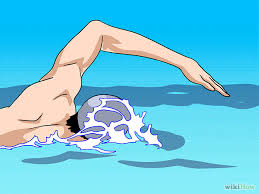David Rifkin is a qualified swim coach who has also competed at international level. He has kindly provided some training tips in freestyle technique for beginners. With only a few months away until summer, now is the perfect time to start training. There are a myriad of triathlons and ocean swims to participate in over summer if you are interested in training towards a goal, or follow these tips to simply get fitter, faster or exercise in a low impact environment.
This is for those who swim less than 1 km and those who are fairly new to the bio-mechanics of freestyle. The points below provide simple tips and breakdowns for the key components of freestyle.
Why drills & cues will improve your ‘A’ game
When you swim any of the main strokes (freestyle, backstroke, breaststroke or butterfly) you might find it hard, especially at the start of your swimming journey. Swimming is not just throwing a ball. Its a complicated sport as it requires you to co-ordinate most of your muscles at the same time, at different times and intensities. For this reason coaches use drills, which break down the stroke into smaller, simpler motions that allow you to master that part of the stroke (eg: the pull through, catch, kick). Now cues are little word rhymes that will help you remember the order and timing for the stroke. Such as Dory in Finding Nemo “ just keep swimming” or when you want to remember the breathing patterns “ blow bubbles in, breath out”.
Body position
The goal is to swim like a “surfboard’ on-top of the water. This means getting your bottom up, chin down and legs making a splash. The line from the back of your head, to your bottom to your heels should be as straight as you can. A good visual trick is to get your back on top of the water and pretend the wind is blowing onto it.
Arms & legs
Swimming arms require strength in your shoulders and lats. To build your strength up fast the trick is to kick a lot harder and focus on a catch up stroke (one arm waiting for the other at the front of the stroke before it commences the catch under your body). This allows you to stay in a surfboard position whilst building your shoulder strength and avoiding the most common issues; criss-cross arms or ziggy zaggy legs. FYI Ian Thorp had this stroke and was an epic fish!
TIP: As you are now kicking more lets make sure you are maximising your kick and moving forward. Your feet must be relaxed and fast. Like a ballerina fluttering as she jumps into the air. But remember the kick starts at the hip and like a whip going through the air it gets faster and tighter near the toes. Start with just kicking in a streamline position (two straight arms squeezing your head and your hands overlapping) and then add in the catchup freestyle.
Breathing
Simple trick. When your heads in the water blow out bubbles from your nose, when you are ready to breath, one arm stays at the front of the stroke and the other begins to pull through. At this point you start turning your head to the side to breath. Keep your ear in the water and your mouth just out and simply breath in. Your hand is now at the end of the stroke (by your waist) and as it starts to recover out of the water (and begin its migration back to the top of your stroke where the other hand is waiting), that’s when your head goes back into the water.
Recap; arm pull through = head to side to breath, arm pull over = head back into water to blow bubbles.
Most common mistakes
Criss-cross arms & zigg-zaggy legs. This is when your arm pull through is not along the side of your body, but rather crossing over your belly button. When kicking, are your two big toes high fiving? if not you might be crossing your feet over. Both of these common mistakes cause you to swim wiggly and put a lot of pressure on your shoulder. The catchup freestyle will help prevent this and being mindful. Its always good to visualise that you are lying on a surfboard and when your arms paddle through the water they stay on the side of the surfboard.
For further training information check out David’s website at www.teamcrushers.com.au
There is information on his swimming clinics, training programs and coaching on stroke correction. Alternatively David can be contacted via email: david@teamcrushers.com.au.

